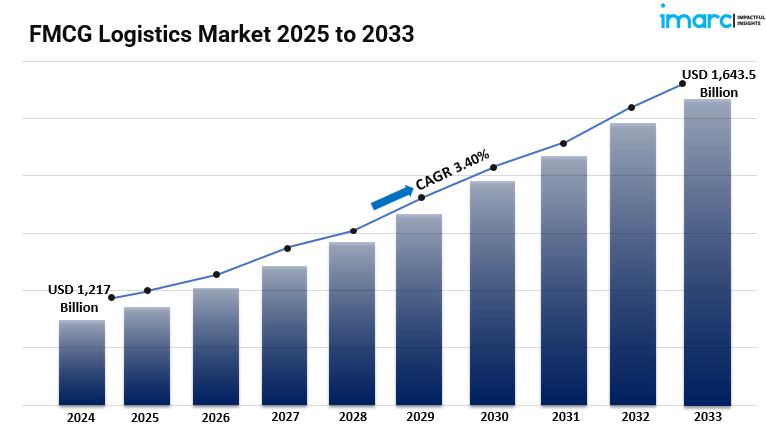Market Overview:
The global Fast-Moving Consumer Goods (FMCG) logistics market is experiencing significant growth, driven by the surge in e-commerce, rapid urbanization, and evolving consumer preferences for convenience. In 2024, the market was valued at USD 1,217 billion and is projected to reach USD 1,643.5 billion by 2033, reflecting a Compound Annual Growth Rate (CAGR) of 3.40% during 2025-2033. Key factors contributing to this expansion include advancements in logistics technologies and increased investments in infrastructure development.
Study Assumption Years:
- Base Year: 2024
- Historical Years: 2019-2024
- Forecast Years: 2025-2033
3. FMCG Logistics Market Key Takeaways:
-
Market Size and Growth: In 2024, the FMCG logistics market was valued at USD 1,217 billion and is anticipated to reach USD 1,643.5 billion by 2033, exhibiting a CAGR of 3.40% during the forecast period.
-
Regional Dominance: Asia-Pacific leads the market, holding over 48.9% share in 2024, attributed to robust e-commerce infrastructure, increasing urbanization, and rising disposable incomes.
-
Service Segmentation: The market is segmented into transportation, warehousing, and value-added services, each playing a crucial role in the supply chain.
-
Transportation Modes: Key modes include railways, airways, roadways, and waterways, facilitating efficient movement of goods across regions.
-
Product Categories: The FMCG sector encompasses food and beverages, personal care, household care, and other products, each requiring specialized logistics solutions.
-
Technological Integration: Adoption of AI-powered logistics solutions, automation, and IoT-based tracking enhances delivery efficiency and transparency.
Market Growth Factors:
The flourishing e-commerce sector is a critical growth driver for the expanding FMCG logistics market. Growing interest in online shopping demands quick and efficient delivery options, which in turn forces logistics companies to work on getting their own operations to be more efficient. The integration of modern technologies like AI-based systems, automation, and IoT-based tracking is aimed at increasing transparency and efficiency in the supply chain. Such innovations allow for monitoring in real time along with predictive analytics, enabling faster and more streamlined processes to ensure on-time delivery and improvement in customer satisfaction.
Urbanization and changing consumer lifestyles are other important factors supporting market growth. More people migrating to urban set-ups would mean comparatively greater access to FMCG products in a demand-driven perspective. Therefore, consumption would boom, and logistics must come into play for the quick movement of goods. Logistics providers have to expand their networks and improve last-mile delivery services-completely to realize such changing consumer expectations; thus, contributing to market growth.
It is also receiving a boost owing to heavy investment into infrastructure development and globalization in the FMCG trade. Both the public and private sectors are investing in transport, warehousing, and technology for efficient logistics. These cross-border trades in the FMCG sector require well-built logistics frameworks to enable cross-border transactions, regulatory compliance, and varied market demands. This consequently smoothens these processes, cuts transit time, and enhances FMCG supply chain efficiency.
Request Sample For PDF Report: https://www.imarcgroup.com/fmcg-logistics-market/requestsample
Market Segmentation:
The FMCG logistics market is comprehensively segmented to address various aspects of the supply chain:
-
By Product Type:
- Food and Beverage: Logistics services tailored for perishable and non-perishable food items and beverages.
- Personal Care: Handling and transportation of cosmetics, toiletries, and personal hygiene products.
- Household Care: Logistics solutions for cleaning agents, detergents, and other household maintenance products.
- Others: Includes miscellaneous FMCG products not categorized above.
-
By Service Type:
- Transportation: Movement of goods from manufacturers to retailers or consumers.
- Warehousing: Storage solutions ensuring product safety and inventory management.
- Value-Added Services: Additional services such as packaging, labeling, and product customization.
-
By Mode of Transportation:
- Railways: Efficient for bulk goods over long distances.
- Airways: Fastest mode, suitable for high-value or perishable items.
- Roadways: Flexible and widely used for regional distribution.
- Waterways: Cost-effective for large volumes over international routes.
Market Breakup by Region:
- North America (United States, Canada)
- Asia Pacific (China, Japan, India, South Korea, Australia, Indonesia, Others)
- Europe (Germany, France, United Kingdom, Italy, Spain, Russia, Others)
- Latin America (Brazil, Mexico, Others)
- Middle East and Africa
Recent Developments & News:
The FMCG logistics sector is witnessing significant advancements, particularly in technological integration. The adoption of AI-powered logistics solutions, automation, and IoT-based tracking systems has notably reduced delivery times and enhanced operational efficiency. These innovations are transforming supply chain management, enabling real-time monitoring and predictive analytics to optimize routes and inventory management. Additionally, there is a growing emphasis on
Note: If you need specific information that is not currently within the scope of the report, we will provide it to you as a part of the customization.
About Us:
IMARC Group is a global management consulting firm that helps the world’s most ambitious changemakers to create a lasting impact. The company provide a comprehensive suite of market entry and expansion services. IMARC offerings include thorough market assessment, feasibility studies, company incorporation assistance, factory setup support, regulatory approvals and licensing navigation, branding, marketing and sales strategies, competitive landscape and benchmarking analyses, pricing and cost research, and procurement research.
